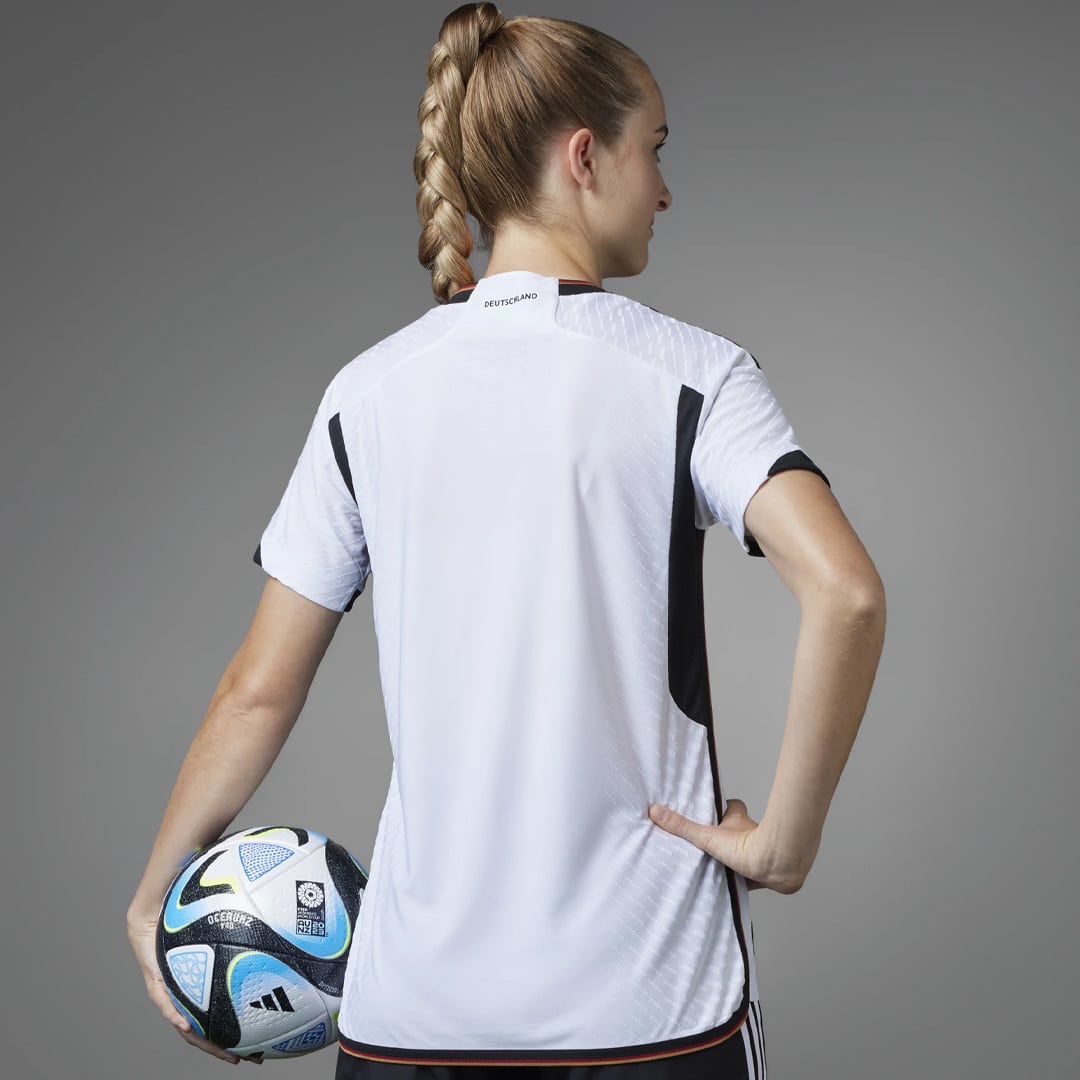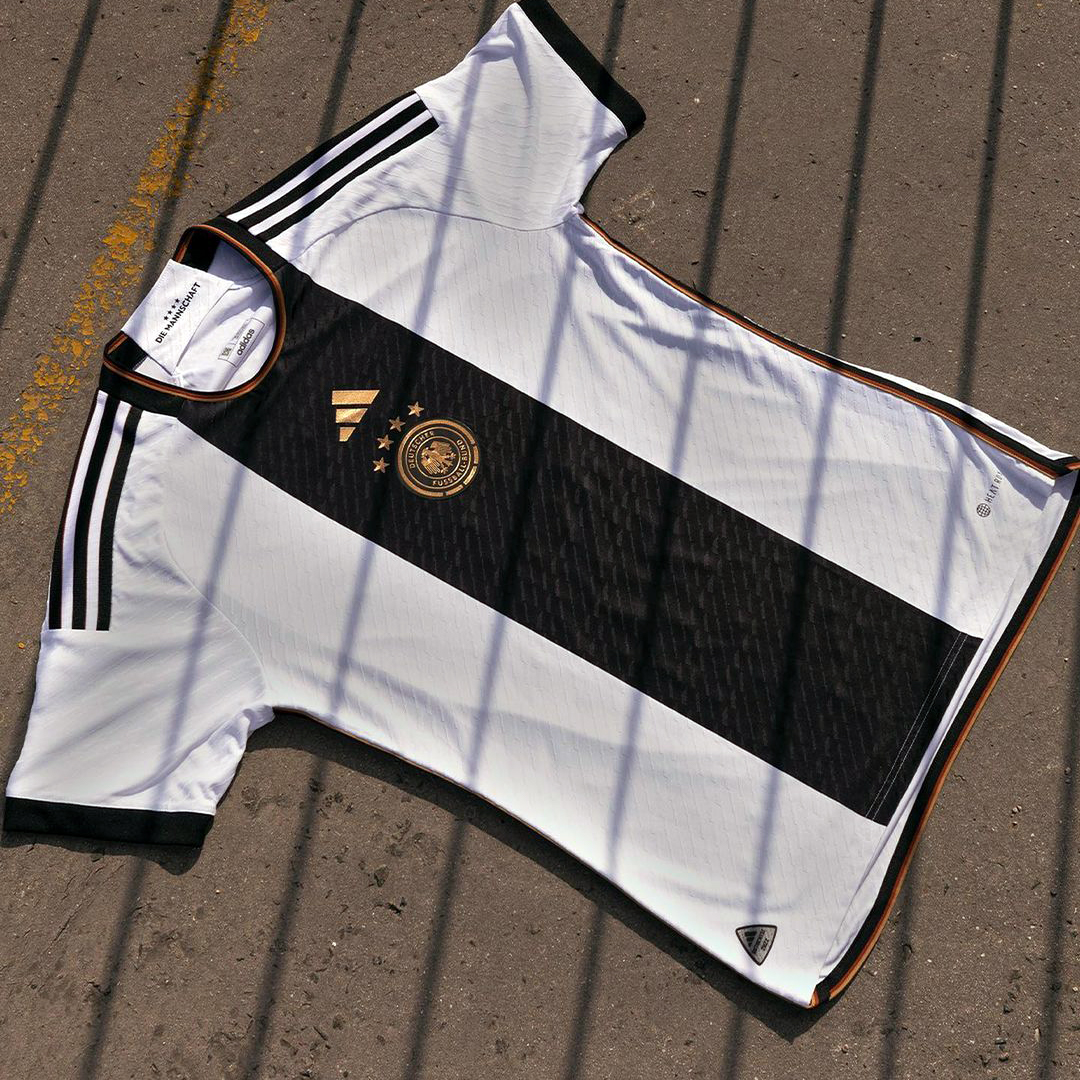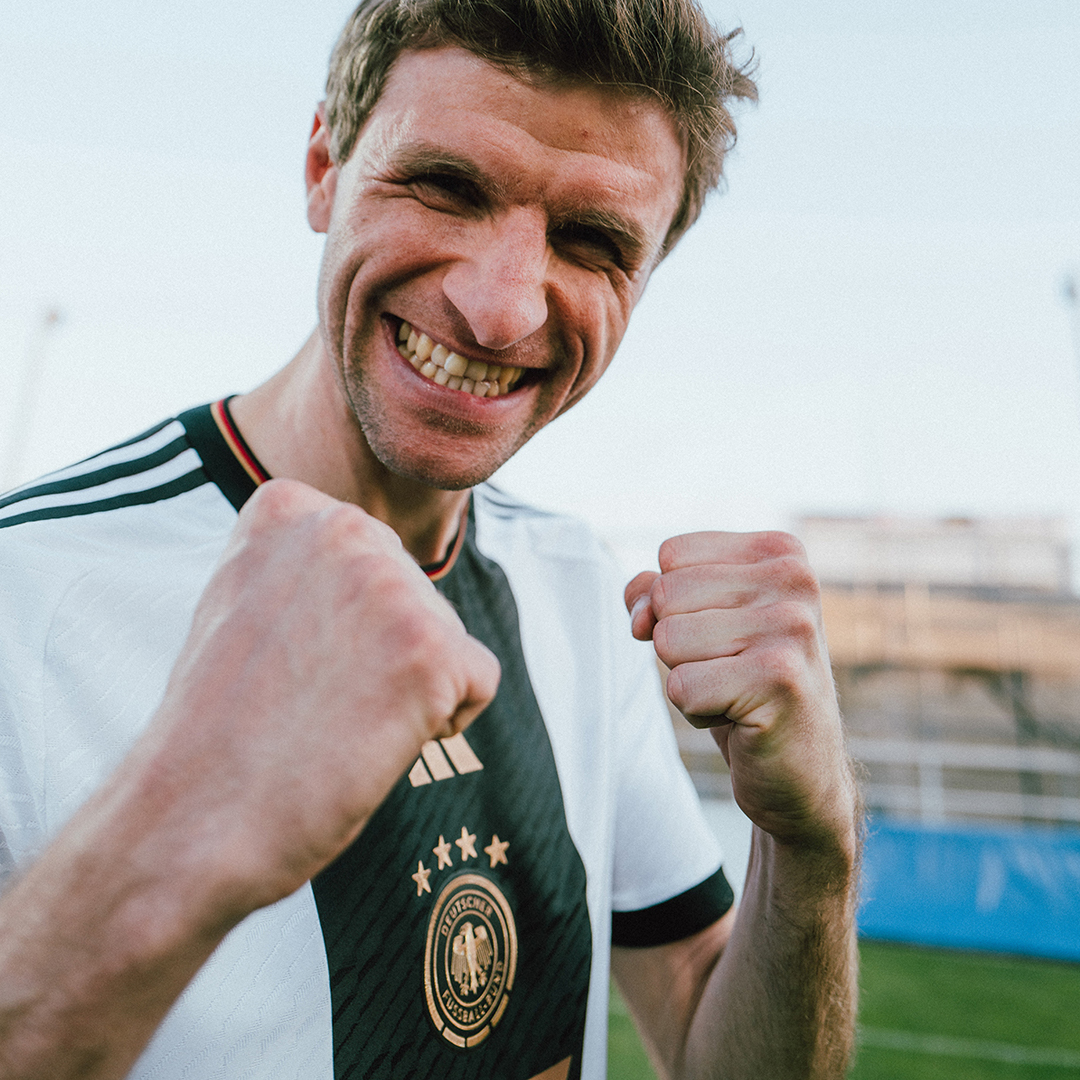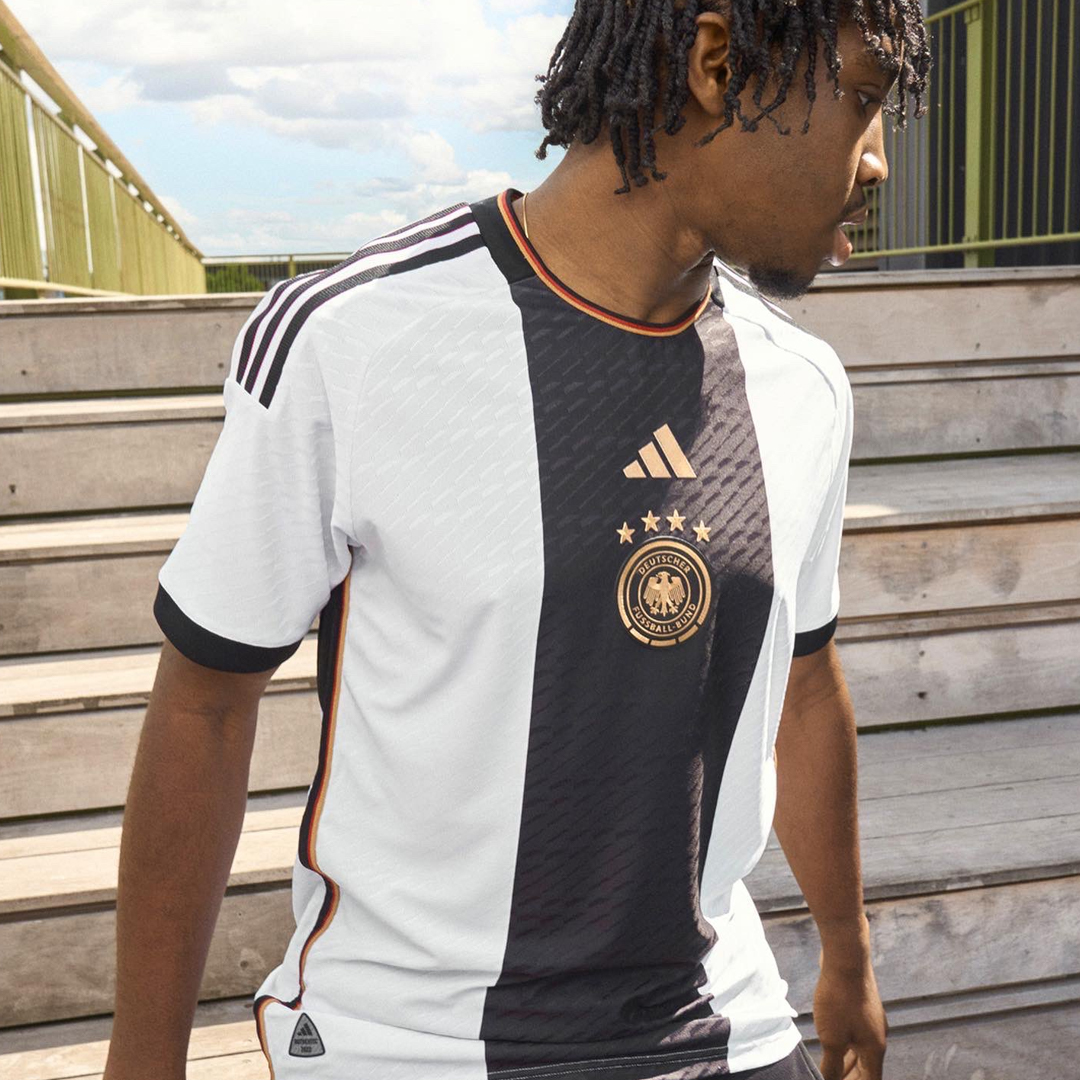See the latest German football kit, as worn right at the heart of their home soil in Euro 2024, as well as the women’s kit displayed during the 2023 Australia/New Zealand Women’s World Cup. Get them all here when you go through the page:
Germany Home Kit
Germany play their home games across the different stadiums in their cities, wearing a home shirt of white. These white shirts are part of one of the most successful national football teams. The Germans have appeared in eight World Cup finals, winning four of them. They have also appeared in six European Championship finals, winning three. The national team’s away shirt colour has changed several times.
2024 Germany Home Shirt
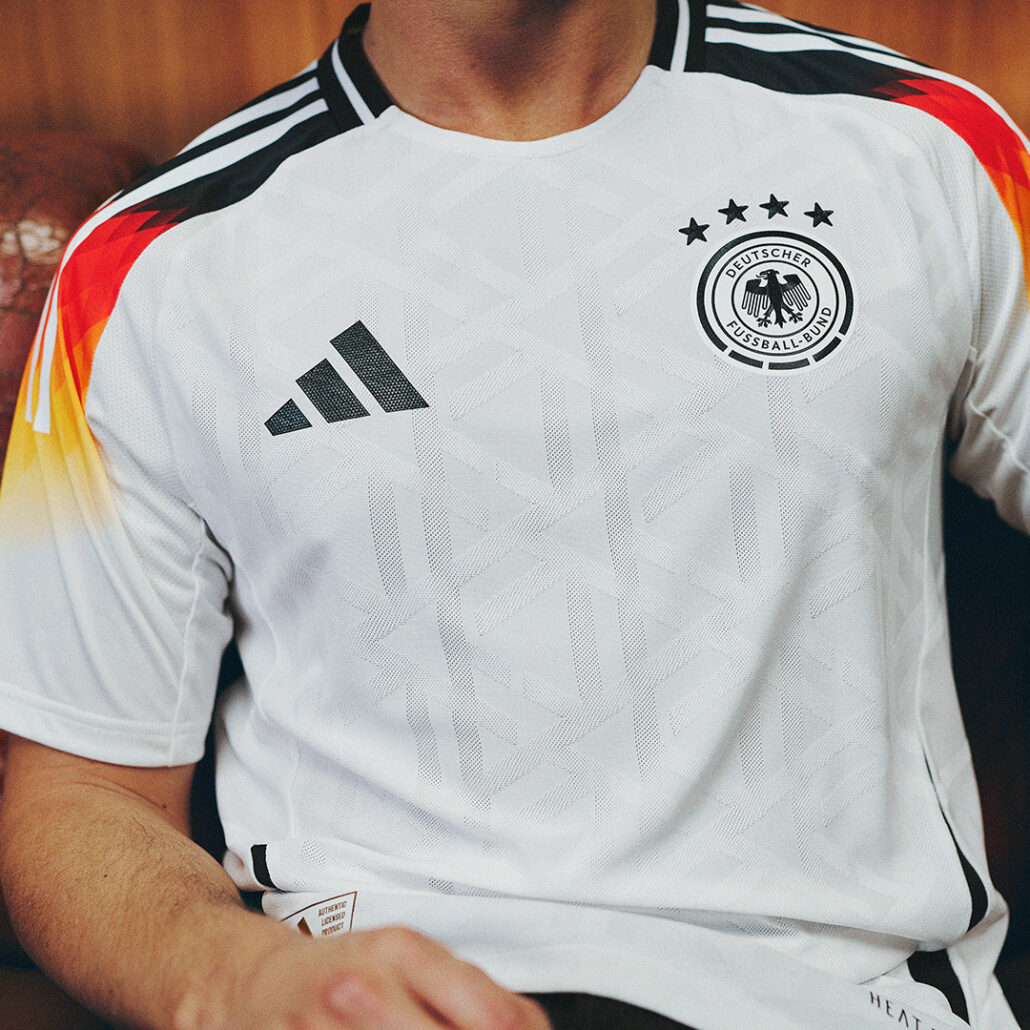 The 2024 Germany home shirt for that year’s Euro tournament has a clean white look for the most part. Much of the design literally rests on the shoulders, which carries a transitional colouring from black to red to yellow starting near the collar. The detailing extends past the shoulders but does not go full blast on the sleeves. Embedded with the said colouring is a subtle repeating diamond pattern that invokes memories of the 1994 World Cup kit. Making this connection more pronounced is the tricolour gradient on the inside of the neckline. And just like the said outfit, the body of the 2024 Germany home carries a tonal pattern, this time a pattern made up of the DFB logo.
The 2024 Germany home shirt for that year’s Euro tournament has a clean white look for the most part. Much of the design literally rests on the shoulders, which carries a transitional colouring from black to red to yellow starting near the collar. The detailing extends past the shoulders but does not go full blast on the sleeves. Embedded with the said colouring is a subtle repeating diamond pattern that invokes memories of the 1994 World Cup kit. Making this connection more pronounced is the tricolour gradient on the inside of the neckline. And just like the said outfit, the body of the 2024 Germany home carries a tonal pattern, this time a pattern made up of the DFB logo.
2022/23 Germany Home Shirt
 Much of the activity on the Germany 2022 World Cup adidas home happens right down the middle of its white-based shirt. A singular wide vertical band, inspired by the 2008 Euro away kit and the racing stripes on cars, flows down centrally, reaching both the collar and the hemline on its ends. In addition, the metallic gold logos also appear on the middle, within the confines of the said band. The black details such as the sleeve cuffs and template shoulder stripes complement the main design and the German flag colours on the collar and lateral trims provide the finishing touches.
Much of the activity on the Germany 2022 World Cup adidas home happens right down the middle of its white-based shirt. A singular wide vertical band, inspired by the 2008 Euro away kit and the racing stripes on cars, flows down centrally, reaching both the collar and the hemline on its ends. In addition, the metallic gold logos also appear on the middle, within the confines of the said band. The black details such as the sleeve cuffs and template shoulder stripes complement the main design and the German flag colours on the collar and lateral trims provide the finishing touches.
2020/21 Germany Home Shirt
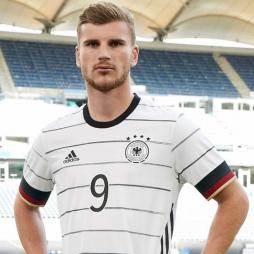 The look of the white-based Germany adidas 2020 home uniform is composed of light pinstripes with wide equidistance. The said pattern goes horizontal on the front side and angled on the sleeves as well as on the shoulder areas on the back. The round neck collar is black as well as the Adidas and team symbols on the chest area. The German flag colours run around the ‘Condivo 20’ wide sleeve cuffs. Three black bold vertical lines are seen on the sides. The back is almost entirely white, with the top part just right under the collar area displaying the crest’s black four stars flanked by the pinstripe shoulder drapings.
The look of the white-based Germany adidas 2020 home uniform is composed of light pinstripes with wide equidistance. The said pattern goes horizontal on the front side and angled on the sleeves as well as on the shoulder areas on the back. The round neck collar is black as well as the Adidas and team symbols on the chest area. The German flag colours run around the ‘Condivo 20’ wide sleeve cuffs. Three black bold vertical lines are seen on the sides. The back is almost entirely white, with the top part just right under the collar area displaying the crest’s black four stars flanked by the pinstripe shoulder drapings.
Men’s Germany Shirt
Germany played their first international in 1908 and since then they have worn white shirts. West Germany wore a white shirt in the mid 50’s after their split with East Germany. East Germany wore the a blue home shirt. In 1990 the two nations reunified to reform Germany. A popular home shirt by Germany was the one used in the 1990 FIFA World Cup where the nation went on to win the title knocking out Netherlands, England and Argentina to claim the crown. The 2014 home shirt that featured had black accents from the cuffs, neckline, and shoulder stripes, and a heightened v-band with a gradient red finish around the chest area, adds to the list of winning German kits. 2020 brings in a white kit designed with horizontal pinstripes displaying a brushstroke effect. The sleeve cuffs mirror the colours of the national flag.
West Germany and Germany have had a series of white shirts with black, red and yellow stripes, bands and chequered styles incorporated. The side have always had black shorts with white socks. Germany’s iconic players who have worn their white home shirt include Franz Beckenbauer, Lothar Matthaus, Gerd Muller, Jurgen Klinsmann, Karl-Heinz Rummenigge, Rudi Voller and Miroslav Klose. Franz Beckenbauer is arguably one of the best midfielders/defenders to ever play the game.
Children’s Germany Kit
Germanys national youth football team consist of teams from the U-20, U-19, U-18, U-17, U-16 and U-15 youth levels. Germany have a strong tradition of producing youth talent.
Germany have produced many stars including Franz Beckenbauer, Gerd Muller, Lothar Matthaus, Oliver Kahn and Rudi Voller.
Germany Women’s Kit
2023 Women's Germany World Cup Home Kit
 The 2023 Germany women’s squad for the World Cup in Australia and New Zealand has carried over the jersey worn by the men’s team in the Qatar World Cup a year prior. That means seeing them in a predominantly white shirt that has a wide black band running down the middle of the entirety of the body. You can make the argument that it is like the black version of an Ajax design. The sleeve cuffs, template shoulder stripes, side trims and round collar all provide black accents, though the latter two also have edge stripings in red and yellow to complete the German spirit of the shirt.
The 2023 Germany women’s squad for the World Cup in Australia and New Zealand has carried over the jersey worn by the men’s team in the Qatar World Cup a year prior. That means seeing them in a predominantly white shirt that has a wide black band running down the middle of the entirety of the body. You can make the argument that it is like the black version of an Ajax design. The sleeve cuffs, template shoulder stripes, side trims and round collar all provide black accents, though the latter two also have edge stripings in red and yellow to complete the German spirit of the shirt.
Germany World Cup Kits
Find Your Shirt
Get Your Kit
More Germany Kits
 World Cup 2022 – After a relatively successful period with Joachim Low that produced a title in 2014, Germany had the Qatar World Cup to kickstart the era of Hansi Flick, who hoped to spread his domestic success to the national side. His wards played with a home shirt notable for its wide central vertical stripe in black and a predominantly black away shirt carrying a maroon all-over graphic. The design was a polygonal representation of the D in Deutschland, applied with a faded and static effect for more dynamism.
World Cup 2022 – After a relatively successful period with Joachim Low that produced a title in 2014, Germany had the Qatar World Cup to kickstart the era of Hansi Flick, who hoped to spread his domestic success to the national side. His wards played with a home shirt notable for its wide central vertical stripe in black and a predominantly black away shirt carrying a maroon all-over graphic. The design was a polygonal representation of the D in Deutschland, applied with a faded and static effect for more dynamism.
 World Cup 2018 – Heartbreak ensued as the defending champions exited in the group stage, becoming the 6th overall and the 3rd consecutive nation since 2010 Italy to do so. The black chest graphic on the white home represented a stylised depiction of the waving of the German flag, while the tealish away kit took inspiration from the popular EQT collection of the ’90s, and added pinstripes applications and abstract solid-filled interconected diamond patterns for an active look.
World Cup 2018 – Heartbreak ensued as the defending champions exited in the group stage, becoming the 6th overall and the 3rd consecutive nation since 2010 Italy to do so. The black chest graphic on the white home represented a stylised depiction of the waving of the German flag, while the tealish away kit took inspiration from the popular EQT collection of the ’90s, and added pinstripes applications and abstract solid-filled interconected diamond patterns for an active look.
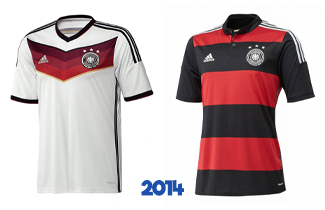 World Cup 2014 – Germany reached the promise land in 2014, after consecutive third place finishes in 2006 and 2010. It was a great moment for the then-debuted Nike Magista Obra as it was worn by Mario Gotze, who scored the winning goal in the finals. The broad chevron chest band with three distinct shades of red provided a memorable detail to this cup-winning German home kit. The change shirt at this time was a broadly hooped shirt in black and red.
World Cup 2014 – Germany reached the promise land in 2014, after consecutive third place finishes in 2006 and 2010. It was a great moment for the then-debuted Nike Magista Obra as it was worn by Mario Gotze, who scored the winning goal in the finals. The broad chevron chest band with three distinct shades of red provided a memorable detail to this cup-winning German home kit. The change shirt at this time was a broadly hooped shirt in black and red.
 World Cup 2010 – One of the talking points for Germany in 2010 was the disallowed goal from England’s Frank Lampard despite the ball clearly going past the line after bouncing off the post. Many in the German camp thought of the decision as going full circle from the controversial 1966 England goal (a similar setup but with the ball clearly not crossing the line) that essentially gave momentum to the nation to finish of Germany en route to the title. In both Euro 2008 (finals) and World Cup 2010 (semifinals), Germany lost to a Spanish side considered as the country’s golden generation. For this World Cup, the home shirt had, running the entire length of the shirt on the left hand side, three pinstripes coloured after the German flag. The black secondary shirt had sufficiently spaced narrow tonal vertical stripes in addition to the pinstriped red trims on the left hand side.
World Cup 2010 – One of the talking points for Germany in 2010 was the disallowed goal from England’s Frank Lampard despite the ball clearly going past the line after bouncing off the post. Many in the German camp thought of the decision as going full circle from the controversial 1966 England goal (a similar setup but with the ball clearly not crossing the line) that essentially gave momentum to the nation to finish of Germany en route to the title. In both Euro 2008 (finals) and World Cup 2010 (semifinals), Germany lost to a Spanish side considered as the country’s golden generation. For this World Cup, the home shirt had, running the entire length of the shirt on the left hand side, three pinstripes coloured after the German flag. The black secondary shirt had sufficiently spaced narrow tonal vertical stripes in addition to the pinstriped red trims on the left hand side.
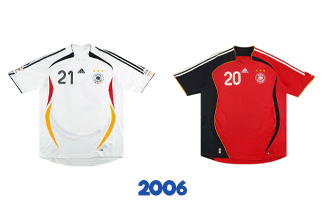 World Cup 2006 – Expectations were low for the Germans in 2006 despite being the host, but did put up a good showing that led to a third place finish. The German colours of black, red and yellow adorned the curved seams of the home shirt, while the away kit had a half-and-half design of red and black for the left and right sleeves (the body remained in red).
World Cup 2006 – Expectations were low for the Germans in 2006 despite being the host, but did put up a good showing that led to a third place finish. The German colours of black, red and yellow adorned the curved seams of the home shirt, while the away kit had a half-and-half design of red and black for the left and right sleeves (the body remained in red).
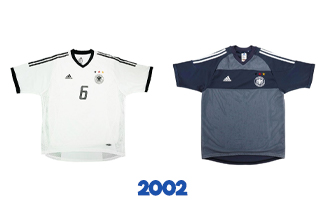 World Cup 2002 – Germany had a plain-looking home shirt in 2002 (with the three stars above the crest the only other colour detail in black, red, and yellow. The same accents were carried over to the alternate shirt, which was predominantly grey, bluish and dark on the sleeves and chest band, and a bit brighter for the rest of the body. Germany’s campaign in this World Cup had lots of surprises. First, despite the rich history of Brazil and Germany in football, their 2002 WC finals match was just their first meeting! Second, Germany was not expected to do much due to their poor qualifiers and managed to go all the way, just failing the final hurdle against a Brazilian side led by the great three Rs of Ronaldo, Rivaldo, and Ronaldinho. Lastly, German Oliver Kahn was awarded the Golden Ball, the first time a goalkeeper was named the best player of the tournament.
World Cup 2002 – Germany had a plain-looking home shirt in 2002 (with the three stars above the crest the only other colour detail in black, red, and yellow. The same accents were carried over to the alternate shirt, which was predominantly grey, bluish and dark on the sleeves and chest band, and a bit brighter for the rest of the body. Germany’s campaign in this World Cup had lots of surprises. First, despite the rich history of Brazil and Germany in football, their 2002 WC finals match was just their first meeting! Second, Germany was not expected to do much due to their poor qualifiers and managed to go all the way, just failing the final hurdle against a Brazilian side led by the great three Rs of Ronaldo, Rivaldo, and Ronaldinho. Lastly, German Oliver Kahn was awarded the Golden Ball, the first time a goalkeeper was named the best player of the tournament.
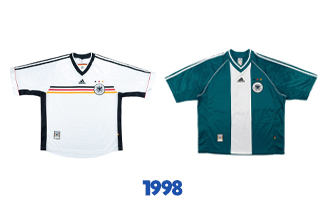 World Cup 1998 – For 1998, Germany had their white home shirt designed with three narrow stripes coloured after national flag running across the chest. The team also opted for a deep-toned teal alternate shirt with a central vertical stripe that was broad and white. With a quarterfinal exit, the nation failed to match its glory in the Euro 1996, the first major title of Reunified Germany.
World Cup 1998 – For 1998, Germany had their white home shirt designed with three narrow stripes coloured after national flag running across the chest. The team also opted for a deep-toned teal alternate shirt with a central vertical stripe that was broad and white. With a quarterfinal exit, the nation failed to match its glory in the Euro 1996, the first major title of Reunified Germany.
 World Cup 1994 – Both the white home and teal away had a rippled polygonal design draping over the top edge of the shirt. The graphic made no mistake that the shirts were for Germany because of the colours representing the national flag. Germany also suffered a quarterfinal upset, this time to Bulgaria via 2-1 scoreline.
World Cup 1994 – Both the white home and teal away had a rippled polygonal design draping over the top edge of the shirt. The graphic made no mistake that the shirts were for Germany because of the colours representing the national flag. Germany also suffered a quarterfinal upset, this time to Bulgaria via 2-1 scoreline.
 World Cup 1990 – The 1990 kits provided the inspiration for the design of the 2018 kits. The angular representation of the waving of the German flag was more pronounced in this cup-winning home kit, having broader stripings that were coloured after the national flag. Also becoming popular was the predominantly green with white spraypaint-like fade alternate kit. The colourway resulted to a 3D effect-a chevron formation of interconnected bricks. Andreas Brehme’s 85th minute penalty secured the title for then West Germany and a measure of revenge against 1986 World Cup champions Argentina.
World Cup 1990 – The 1990 kits provided the inspiration for the design of the 2018 kits. The angular representation of the waving of the German flag was more pronounced in this cup-winning home kit, having broader stripings that were coloured after the national flag. Also becoming popular was the predominantly green with white spraypaint-like fade alternate kit. The colourway resulted to a 3D effect-a chevron formation of interconnected bricks. Andreas Brehme’s 85th minute penalty secured the title for then West Germany and a measure of revenge against 1986 World Cup champions Argentina.
 World Cup 1986 – The white home and green away kits this World Cup featured a templated design of tonal rhombuses formed into a diagonal striping formation. Before the payback in the succeeding 1990 WC, Germany suffered a close 3-2 defeat at the hands of the Diego Maradona-led Argentina, finishing as runners-up in the second Mexico edition of the tournament.
World Cup 1986 – The white home and green away kits this World Cup featured a templated design of tonal rhombuses formed into a diagonal striping formation. Before the payback in the succeeding 1990 WC, Germany suffered a close 3-2 defeat at the hands of the Diego Maradona-led Argentina, finishing as runners-up in the second Mexico edition of the tournament.
 World Cup 1982 – The respective black and white accents of the home and away German kits in ’82 mainly came from the polo collar with shallow v-neckline and the shoulder stripes that extended to the sleeves. 1982 was another runners-up finish, this time to Italy.
World Cup 1982 – The respective black and white accents of the home and away German kits in ’82 mainly came from the polo collar with shallow v-neckline and the shoulder stripes that extended to the sleeves. 1982 was another runners-up finish, this time to Italy.
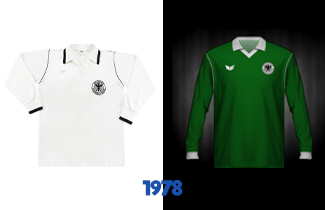 World Cup 1978 – Minimal black trims (the pinstriped ones on the standard sleeve cuts and the bold marking on the edge of the polo collar) provided a few details to the ’78 German home kit. The green alternate shirt also had the same details in white minus the collar marking as the said part was already white. Germany ended the campaign in the second group stage.
World Cup 1978 – Minimal black trims (the pinstriped ones on the standard sleeve cuts and the bold marking on the edge of the polo collar) provided a few details to the ’78 German home kit. The green alternate shirt also had the same details in white minus the collar marking as the said part was already white. Germany ended the campaign in the second group stage.
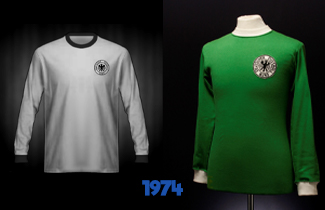 World Cup 1974 – Germany hosted and won the 1974 World Cup, and did so against a Johan Cruyff-led Netherlands that operated with their vaunted Total Football philosophy. The Franz Beckenbauer-captained German side became the first country to hold the Euro and World Cup titles simultaneously, which got replicated several years down the line (France in 2000 and Spain in 2010). Tight-fitting round collars in black and white, respectively, outfitted the German kits.
World Cup 1974 – Germany hosted and won the 1974 World Cup, and did so against a Johan Cruyff-led Netherlands that operated with their vaunted Total Football philosophy. The Franz Beckenbauer-captained German side became the first country to hold the Euro and World Cup titles simultaneously, which got replicated several years down the line (France in 2000 and Spain in 2010). Tight-fitting round collars in black and white, respectively, outfitted the German kits.
 World Cup 1970 – The ’70 German outfits had the same look as the succeeding ’74 kits, except for the v-neckline collar. It was in this World Cup that Germany and Italy played what was dubbed as the Game of the Century. Italy led 1-0 for almost the entirety of the semifinals match, only for Germany to equalise in the dying minutes. At extra time, a back and forth of goals led to a dramatic 4-3 victory for the eventual runners-up Italy.
World Cup 1970 – The ’70 German outfits had the same look as the succeeding ’74 kits, except for the v-neckline collar. It was in this World Cup that Germany and Italy played what was dubbed as the Game of the Century. Italy led 1-0 for almost the entirety of the semifinals match, only for Germany to equalise in the dying minutes. At extra time, a back and forth of goals led to a dramatic 4-3 victory for the eventual runners-up Italy.
 World Cup 1966 – Germany’s ’66 kits had a similar look as their uniforms in ’74, employing the bespoke white and green base with black and white collarsfor the home and away shirts, respectively. Germany reached the finals of ’66 against host England. Tied 2-2 going into extra time, momentum shifted to the home side with the controversial third goal(whether the ball fully moved past the goal line is still debated to this date)being awarded. Geoff Hurst added another one at the last minute, producing the now-iconic ‘It is now…’ commentary.
World Cup 1966 – Germany’s ’66 kits had a similar look as their uniforms in ’74, employing the bespoke white and green base with black and white collarsfor the home and away shirts, respectively. Germany reached the finals of ’66 against host England. Tied 2-2 going into extra time, momentum shifted to the home side with the controversial third goal(whether the ball fully moved past the goal line is still debated to this date)being awarded. Geoff Hurst added another one at the last minute, producing the now-iconic ‘It is now…’ commentary.
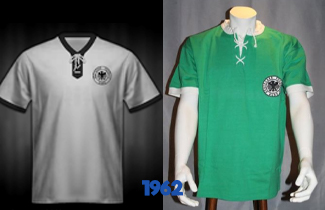 World Cup 1962 – A unique feature of the ’62 (as well as the ’58) German kits were the laces under the neckline. Germany topped its group but lost in the quarterfinals to Yugoslavia 1-0.
World Cup 1962 – A unique feature of the ’62 (as well as the ’58) German kits were the laces under the neckline. Germany topped its group but lost in the quarterfinals to Yugoslavia 1-0.
Germany are one of the strongest national teams in Europe and the world as they have been in several finals and semi-finals of the FIFA World Cup and UEFA Euro tournaments which gives their nickname of ‘Die Mannschaft’ meaning ‘The Team’. Since their first international in 1908 (playing back then as West Germany) the team wore black and white home shirt that later evolved into a white home shirt which they still currently wear today. The nation’s away shirts had mostly been green as a nod to Ireland, the first team to play them after the World War. In the 2020/2021 season though, the away shirt has been black, contrasting with the white home kit.
The German national football team played their first international against Switzerland in Basel, Switzerland on the 5th April 1908, Switzerland won the game 5-3. Germany have had several iconic footballers play for their colours including Franz Beckenbauer, Gerd Muller, Lothar Matthaus, Andreas Brehme, Oliver Kahn, Karl-Heinz Rumenigge, Rudi Voller, Jurgen Klinsmann, Michael Ballack and Miroslav Klose. Germany boasts several household names in their squad including Mario Gotze, Bastian Schweinsteiger and Manuel Neuer. The 2020s have seen the likes of Toni Kroos, Serge Gnabry, and Timo Werner rise to the forefront of German Football.
Germany have hosted the FIFA World Cup on two occasions, in 1974 which they won and in 2006. In addition to their 1974 title, Germany also had the title in 1954, 1990, and 2014. Germany have famously been runners-up in the World Cup on four occasions and three occasions in the UEFA Euro Championships.
Germany Kits at European Championships

Euro 2020 – Courtesy of goals from Gnabry, Goretzka, Kroos, and other German star players, Germany placed first in Group C of the qualifications. A cluster of European heavyweights is formed with Euro 2020’s Group F composed of Germany, France, Portugal, and Hungary. Euro 2020 presents Germany a way back to football summit after coming up short from the previous Euro and stumbling out of the World Cup 2018 group stage. Accompanying their quest are a white round-necked shirt with brushstroked pinstripes and a two-toned black v-neck shirt. Both shirts have broad cuffs that have the colours of the German flag.
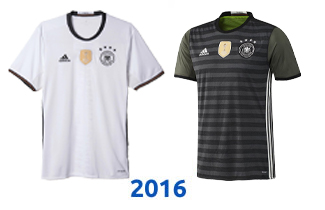
Euro 2016 – Three-time winners of the illustrious European Championship trophy, Germany hoped to match their winning feat last experienced in 1996, but came up short against host France in the semifinals. Arguably the most gifted team in Europe and with substantial strength in depth, Germany took to the French pitches with highly talented players wearing a nostalgic home shirt of pure white with intricate flag-inspired trim and of course the FIFA World Cup winners crest at the mid-chest. A revolutionary away shirt was also showcased in two-tone grey composed of a hooped display of which can be reversed to reveal a bib-like visual in volt yellow.

Euro 2012 – Given a modernistic take on their traditional style of a white base, Germany’s home shirt for Euro ’12 featured a clean white paint-job which featured the German flag colours of black, red, and yellow in a stylish diagonal sash pinstripe covering the front panel of the shirt. Possessing the major talents of Mesut Özil, Thomas Müller, Philipp Lahm, Toni Kroos, Marco Reus, and Mario Gotze the German team progressed through the tournament to the Semi-Finals where they were narrowly beaten 1-2 by Italy. The away look for Germany within Euro ’12 took inspiration from the green shirts worn by the victorious ’72 team of which included legends Franz Beckenbauer and Gerd Muller of whom’s names were printed within the collar for an honorary mention.

Euro 2008 – adidas ClimaCool technology was introduced onto the Germany shirt for Euro 2008, held in Austria and Switzerland, of which helped the team to progress into the Final of the competition to face eventual winners Spain after a close-fought 0-1 loss. Wearing their home shirt in the Final, the look included a traditionally styled white base however incorporated a unique horizontal stripe which adorned the chest panel, encasing the national club crest and adding red and yellow trims to emulate the German flag. A different kit template was used for the away shirt which displayed a vivid red base with a central stripe of black with complementing white adidas three-stripes covering the shoulders and sleeves.
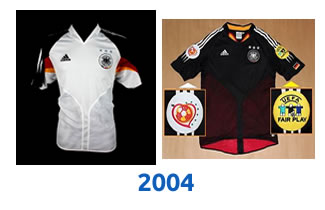
Euro 2004 – Euro 2004 saw shirt design take futuristic steps through the use of modern materials and technology to provide lightweight and breathable concepts as displayed through Germany’s shirt within the competition. Worn by the talented players of Michael Ballack, Philipp Lahm, Bastian Schweinsteiger, and Miroslav Klose, the home shirt showcased a trademark look for the German’s white with complementing sleeves of black, red and yellow to emulate the German flag. The away shirt used the same template as the home kit however reversed the colour-way to a black base with white and red trim, whilst both versions of the shirt possessed an innovative mesh-like material on the lower part of front panel.

Euro 2000 – Arriving at the UEFA European Championship 2000 held in the Netherlands and Belgium, Germany possessed arguably the most star-studded squad of the competition with the likes of Oliver Kahn, Lothar Matthäus, Michael Ballack, Dietmar Hamann, and captain Oliver Bierhoff. Matching the high quality list of German players, the team’s home shirt displayed a classy white body of which was broken-up by solid black sleeves, whilst finishing touches came in the form of red detailing within the polo-neck collar. An alternate shirt consisting of the commonly used green was incorporated with white side panels and further white trim applications to be used when facing opponents of the same home colours.

Euro 1996 – Captained by the iconic Jurgen Klinsmann, Germany took to the English grass at Euro ’96 wearing a classically designed home shirt consisting of a pure white base with patriotic black, red and green trim to match the German flag colours. With Germany reaching the final however trailing their match 0-1 to Czech Republic, manager Berti Vogts substituted Oliver Bierhoff to help change the game and the player did just that by dramatically scoring an equaliser followed by an iconic 95th minute after extra time winner to see the prestigious UEFA trophy held aloft to their adorning fans. An alternative shirt in a green tone consisting of unique adidas three stripes flowing down the shirts shoulders and onto the chest panels was introduced when a kit clash would be presented.

Euro 1992 – The reunified Germany arrived at Euro ’92 showcasing a home shirt of which held reminiscence to their previous look four years earlier through a similar graphic block pattern, but incorporated the design to create a patterned sleeve emulating the German flag. There was also a green alternative of the same design in case of a kit clash. The team, captained by Andreas Brehme, reached the final wearing their white home shirt. However, they came up short against underdogs Denmark losing 0-2.
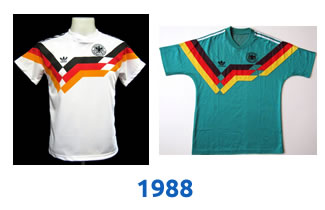
Euro 1988 – The ’88 edition of the UEFA European Championship saw West Germany host the competition and do so in unique fashion through their shirt design by adidas which showcased a striking block graphic in German flag colours flowing across the chest panel and sleeves. Already providing arguably the most distinctive shirt of the tournament, West Germany backed up their home look through an equally eye-catching away shirt using the same graphic template however opting for a green base.
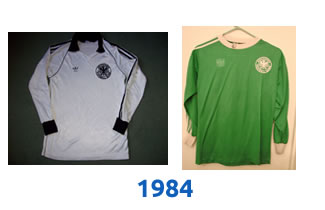
Euro 1984 – Similar to the shirt worn in the previous edition of the competition, West Germany arrived at Euro ’84 held in France as champions and showcased a nostalgic white home shirt with trim applications of black incorporated through a polo-neck collar and adidas branding running down the sleeves. Included for an away look for West Germany saw a traditionally coloured green shirt worn by the likes of Rudi Völler, Karl-Heinz Rummenigge and Lothar Matthäus.
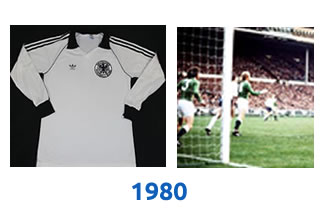
Euro 1980 – Held in Italy, West Germany travelled to the 1980 UEFA European Championships with a new-look squad missing the likes of national heroes Franz Beckenbauer and Gerd Muller but included new additions in Karl-Heinz Rummenigge and Horst Hrubesch. The latter helped the team lift the winners trophy after scoring a brace in a dramatic victory over Belgium. Germany took to the Italian pitches wearing a classic white shirt which featured a traditional polo-neck collar in black, the same accent used for the iconic adidas three-stripes and sleeve cuffs. An alternate shirt of green was used when required due to kit clashes.

Euro 1976 – West Germany arrived at the 1976 European Championships in Yugoslavia as reigning champions, with the majority of pundits and fans regarding the team as firm favourites of retaining the title. Wearing a home shirt of elegant white with black trim applied to the crew-neck collar and sleeve cuffs, West Germany’s expert efficiency and organisation helped the team reach the final to face the technically gifted side of Czechoslovakia. The game finish as a 2-2 draw, consequently leading to a dramatic penalty shootout that saw the Czechs win 5-3. The away strip for West Germany showcased a vivid green shirt as seen within the previous edition of the competition.

Euro 1972 – West Germany experienced their first taste of European Championship football in the 1972 tournament held in Belgium. West Germany’s squad was full of global superstars including Franz Beckenbauer, Gerd Muller, and Paul Breitner, all of whom helped the team to lift the illustrious trophy after convincingly beating the Soviet Union 3-0 in the final. Making their debut within the tournament, West Germany wore a home shirt consisting of a traditional white base with black accents of which poses as a trademark look for the national team. West Germany’s iconic green away shirt was also showcased through a rich green base with clean trim applications of white, inspiring the Germany kit of 2012 that also used a luxurious green base and paid tribute to the 1972 heroics by printing the year inside the collar with names Franz Beckenbauer and Gerd Muller underneath in homage of their victory.


